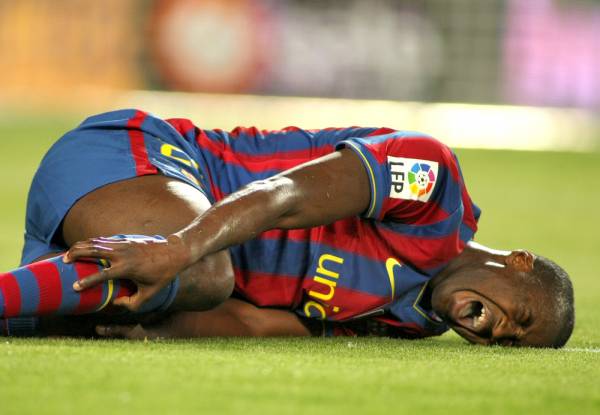This article is part one of an exploration in facing your body, mind, and pain.
“The wound is the place where the Light enters you.” – Rumi
It seems like the best way to end up in pain is to move too much or move too little. Fundamentally pain arises from a lack of balance in our lives, whether in a literal sense or a figurative one. If we look at our society at large, we notice two polar opposite trends. There are those who are completely sedentary and/or obese, who have a subsequent prevalence of pain and disease. However, there is also a supremely fit population on the other end of that spectrum. While we have the fattest country on the planet, our culture still dominates the world stage in athletics and has a large population who are beyond fit. Whether it’s through use of the emerging trends such as adventure races and CrossFit or traditional modes of exercise, increasingly our culture has more fit people than arguably anywhere.
Interestingly enough these two extremes have a relationship and correlation to pain, both physically and emotionally speaking. This pain tells us a lot about our collective emotional health. Clearly obesity in its inherent nature signifies a lack of balance. A sedentary person seeks comfort in the moment by being, well, sedentary. It’s certainly more comfortable to eat and watch TV on a sofa than to run five miles. However, that choice to seek comfort in the moment is a clear choice to avoid pain. The irony is that is exactly where someone who eats copiously and doesn’t move ends up – permanently uncomfortable and in pain.
But what about being super fit? Are fit people running from a pain of sorts and possibly even running right into it as well? In a particularly tough stretch of my life I was running and exercising multiple times daily to manage (or avoid) the stress and pain of that time. While on the surface exercise is better than, say, self-medicating through food or drugs, it can still be an avoidance of pain, and therefore a round trip right back to it. At that time, my father in noticing my gaunt frame and tense body asked, “Son, what are you running from?” Good question, Dad.
The reality is pain cannot be avoided in our lives. It occurs and in the long run it can only be faced. At a certain point pain should even be seen as a welcome adversary, for pain is perhaps our best teacher. Indeed we learn through our trials. Every athletic or physical injury that I’ve suffered has had a sliver lining. First, pain has made me a better-educated and more empathetic coach. Second, it has led me to make better-informed decisions as an athlete. Most importantly though, such trials have helped me grow personally.
Pain Happens: Face It and Switch Directions
I bulked up in my twenties, putting twenty plus pounds of muscle (in my upper body, of course) on my lean frame that doesn’t really support such weight. In the process I partially tore my rotator cuff and it required surgery. The rehabilitation process was extensive and it forced me to search for other arenas to exercise and express myself physically. I picked up my first road bike at that time, which I ended loving and making a part of my life. Instead of focusing on what I couldn’t do, I found something I could. Pain of a different sort can also be a guide. After a particularly tough stretch in my life – the loss of both a relationship as well as other major life changes – I was led to step into a martial arts studio and begin my journey there. Years later, it’s part of my life’s work and I have become a coach.
 When you are going through pain or a trial, it seems there’s always those people who like to lend you that wisdom of “everything happens for a reason.” You feel like punching them, but you can’t because your either too bruised emotionally or physically to do so. Even though we hate to hear this, they are right in a way. This old adage is irritating, because why on Earth would bad things happen to good people? Well, they don’t happen on purpose, so to speak. They happen because each and every one of us grows, learns, and becomes either better or worse by these trials and how we face them. Pain happens for the reason of being our guide and teacher. The pain happens and then we must find acceptance, support, and a new way forward.
When you are going through pain or a trial, it seems there’s always those people who like to lend you that wisdom of “everything happens for a reason.” You feel like punching them, but you can’t because your either too bruised emotionally or physically to do so. Even though we hate to hear this, they are right in a way. This old adage is irritating, because why on Earth would bad things happen to good people? Well, they don’t happen on purpose, so to speak. They happen because each and every one of us grows, learns, and becomes either better or worse by these trials and how we face them. Pain happens for the reason of being our guide and teacher. The pain happens and then we must find acceptance, support, and a new way forward.
Acceptance
When we finally stop to face the pain and listen with humility, we put ourselves in a position to grow, learn, and ultimately move past it. Facing the pain is the first step and it is the biggest step. It is here where we stop to sit with it and develop our game plan in and around it. As a teacher once said to me, “Eric, lean into the pain.”
Support
When we are in pain, we need help. We need good counselors, good healers, and good coaches. We need to get help, but not always in the way we typically seek it. In wanting to get rid of pain, many of us will seek those who would help us mask it. However tempting, we have to think bigger and broader, and recognize that pain will always return until we get the message and truly deal with it. Rather, seek those who will help you answer what caused your pain and what comes next.
 Change
Change
Martin Luther king Jr. said it well: “If you can’t fly then run, if you can’t run then walk, if you can’t walk then crawl, but whatever you do you have to keep moving forward.” Facing pain is about first accepting and then moving forward. You can’t keep running if your knee is in pain. You need to stop, face your pain, and then do something else (for a while, at least.) When I tore my rotator cuff, lifting weights in the upper body and baseball were out for a year, and road biking was in. I kept moving forward.
In part two I will explore the mind-body connection to pain. We’ll look at the lack of balance that causes pain, and the process of making the physical mental and the mental physical.
Is there a time in your training or in your life when you’ve experienced pain? What helped you most – denying it or acknowledging it? Post your thoughts to the comments below.
Photos courtesy of Shutterstock.






